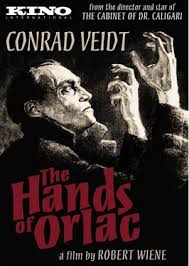
Paul Orlac (Conrad Veidt) is a concert pianist. His life is his hands. When returning home from a concert his train derails. His wife Yvonne (Alexandra Sorina) hears about the accident and rushes to his side. Paul is found in the twisted wreckage and brought to the hospital. He has a skull fracture and his hands are destroyed.
Yvonne begs doctor Serral (Hans Homma) to save Paul’s hands. At that moment a convicted murderer called Vasseur is being executed. The body is brought to doctor Serral for experimentation. Dr. Serral transplants Vasseur’s hands onto Paul. Paul has a long convalescence. During that time he learns that he now has the hands of a murderer. The thought of it weighs on his mind. He becomes obsessed with the idea that his hands were used to kill someone. He begins to believe that his hands are taking over his mind. Paul finds a knife stuck in his front door. The knife is the same as the one Vasseur used to kill. He hides the knife in his piano. His doctor tries to convince him that his hands don’t rule him his head does. Paul is not convinced.
Paul is no longer able to play the piano. Eventually they run out of money and the creditors demand payment. Yvonne tries to go to Paul’s father for help but Old Orlac (Fritz Strassny) hates his son and refuses to help. Yvonne tells Paul that he needs to go to his father himself to try to convince him to help them.
Paul eventually relents and goes to see his father. When he gets there he finds his father has been murdered with the knife he had hidden at home. Paul rushes home and finds that the knife he hid in the piano is missing. Paul thinks that somehow he killed his father. When the police investigate they find Vasseur’s fingerprints all over Paul’s father’s house. A man approaches Paul and tells him that he is Vasseur and that his head was transplanted onto one of Dr. Serral’s orderlies. He also shows Paul his hands. Instead of regular hands he has prosthetic ones. Paul now fully believes that he has Vasseur’s hands and is using them to kill.
“The Hands of Orlac” was released in 1924 and was directed by Robert Wiene. It is an Austrian silent horror film based on the book “Les Mains d’Orlac” written in 1920 by Maurice Renard. The film has been remade at least three times as “Mad Love” 1935, “The Hands of Orlac” 1960 and “Hands of a Stranger” 1962.
At one point, due to various cuts and German censorship, the film was incomplete. The film was restored to its original length in 1995 by F. W. Murnau Stiftung. The main problem the German’s had with the film was the wax fingerprint method depicted in the film for framing someone for murder. Reportedly, the ministry of the interior of Saxony wanted the film censored because it might endanger public safety. The application stated: “Based on an assessment by the Provincial Criminal Office at Dresden the Government of Saxony does not think it appropriate to make publicly known the internal arrangements and tools of the criminal police, particularly in connection with the taking of finger prints, as this would make the fighting of crime more difficult. Further, the representation of means which enable the criminal to obliterate his prints and deceive the police, is highly unsuitable." The application was shot down when the Berlin police department concluded that what was shown in the film was pure fantasy.
Between this film and “The Cabinet of Dr. Caligari” 1920, I’m turning into a fan of Robert Wiene and Conrad Veidt. Wiene’s German Expressionistic flair and his noir touches make anything creepy. His use of fade outs and fade ins between scenes cast a dark gloom to the story. Veidt has an intensity that he brings to his characters that transcend the silence of the silent film. He speaks in anguished volumes with a look and a sway. It’s fascinating to watch his fluid moves across the screen.
There aren’t many action sequences to the film but the train accident devastation is amazing. It picks up after the crash but the set and lighting make you think that maybe you did see a train wreck. Again Wiene has those unusual camera angles and lighting that add depth to the scene.
I’ve seen several adaptations of Maurice Renard’s book. Most of them have been good for one reason or another. This one is no exception. As for my favorite, it’s a tossup between this one and “Mad Love” with Peter Lorre. You can’t go wrong with either one.

